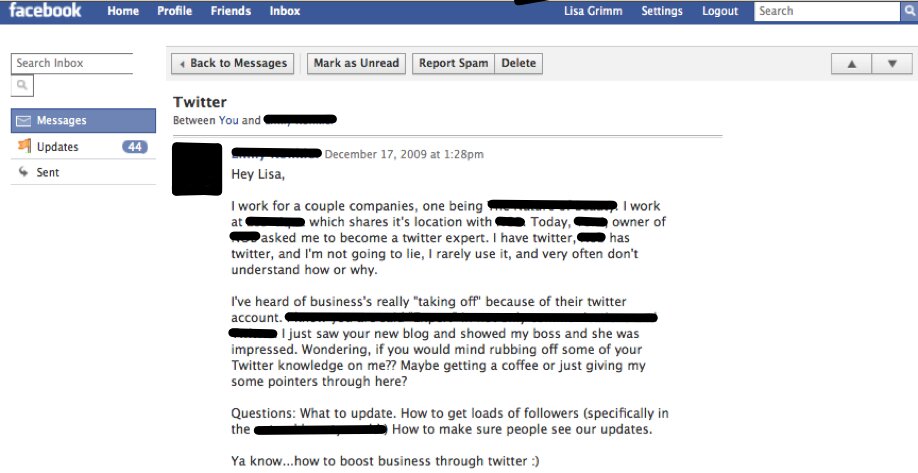In addition to my great social media friends and colleagues, I have a lot of wonderful friends and connections that do not hang in the social media sphere per se. These are folks that may use Facebook, LinkedIn or MySpace (yes I just said MySpace) for personal use, people that are just getting on various social networks to make professional connections or reunite with people from high school or college. Their intentions do not exceed this purpose, however, the desire to do more as the result of mass growth in social media use for business, etc. is sparking curiosity. I get messages from many of them saying things like, “Half the time, I don’t even know what you’re talking about.” It’s not that they’re disinterested (well, some are and give me a hard time); it’s that many of my status updates aren’t really relevant to them. I forget most of the time that terms like augmented reality and mentions of various mediums like Twitter, Foursquare and Plancast etc. are not really that commonplace. With that being said, it’s time to talk to those that don’t really talk about and/or do this stuff ALL THE TIME.
I want to take this opportunity to directly and more thoroughly approach a series of related questions that one of my IRL (in real life) and Facebook friends asked me after my last blog post. (I’d be so grateful if experienced readers take this opportunity to share your thoughts and help others that know far less than you do). I’ve inserted her Facebook message below. NOTE: To capture this image and make quick and easy edits I used a program called Skitch. Skitch is a great tool to pull images off the Web, edit them and convert for easy insertion into documents and blog posts.
I’d like to start by thanking Jane (fictitious name) for asking me her questions, allowing me to use her private question to me as subject matter to post. To keep the identity of her business and name private, I’ve blacked out references to each.
Jane is in a position, like many I know, where she serves as content curator for her workplace(s), spokesperson and brand evangelist for what she represents. While she is all of these things, she’s not familiar with how social media can help her spread the word about her awesome company, its product benefits and brand promise. The boss has assigned her the task. As the result, she’s asking:
What to update? How to get loads of followers? How to make people see our updates?
These are great questions and I’m so glad she asked (me – and I’m hoping you too). The questions are tricky to answer directly because there are quite a few steps in between these questions. Some conversation starters are below (I replied to her privately as well). My goal here is for as many peeps as possible to come in and share links (perhaps to a related post you’ve written) to helpful resources for beginners and drop a useful tip that address her questions. I’ll cover a few, as we’d be here quite a while if I tried to cover it all.
Because I believe that newer communication tools are about creating a two-way dialogue (instead of one-way message distribution model), here are a few suggestions for learning about existing communities and how you may create your own.
Primary and Secondary RESEARCH. My number one approach to just about anything is RESEARCH. I like a blended approach of secondary research (research that others have done and documented) and primary research (gathering my own conclusions and data as the result of first hand experience).
Some helpful secondary resources I use are Google, Twitter Search, Technorati or BlogPulse (blog search tools). You’d be surprised what you’ll dig up as you move through the resources that come up. One thing leads to another. There are many blogs that cover social media and creating online communities out there (they touch the technology piece all the way down to strategy and supporting subjects). Your blog searches will help you hone in on these. Some of my favorites are: Chris Brogan, Brian Solis, Social Media Examiner and Mashable. Others I enjoy can be found in my ‘Stuff I Read’ section.
In regards to primary research, hop on and establish yourself in the mediums you plan to participate in. Practice makes perfect, right? So, if you’re comfortable enough after you know what Twitter is, open an account. WATCH and LISTEN to people. Using Twitter Search (search.twitter.com) seek out keywords that are relevant to you using quotes. (Example “public relations” or “social media.”) By searching for specific terms, you will be able to find exactly who is talking about the subject matter you are interested in. This will help you determine if you want to follow this person/people and if the conversation is a place you want to engage. If you have a prospect list or are curious if specific people are utilizing Twitter (or another medium), go to Google and type in “Jane Doe on Twitter” and anyone by that name will pop up. This is very useful, as you can get granular very easily to determine where you should be spending your time.
Analyze your research. Upon gathering information, sift through it and make some decisions about what you’ve found. Does the data found fit within the overall PR, marketing and business strategy of your company, or will it help you develop a stronger mar-comm strategy? Perhaps you will determine that you need to set up some Google Alerts and use Twitter Search everyday for a week or month and log the results to get a better idea of what’s being said and how you may create community for your people. Does your company culture suit having open conversations with its publics (hopefully it does), or does it just want to blast out one-way messages in hopes of making a sale? If that be the case, you may want to just advertise to save your brand’s reputation.
Closing thought.This may be shocking, but if you know how to talk with another human being,  and I’m talking like human-to-human, none of these things will be a problem for you. Yep, I said that. Think about it. These mediums are tools that allow communicators the ability to do what they’ve been doing all along: CONNECT with (audiences) people by realizing common interests (which suggests that you’re a good listener), SHARE and GIVE of yourself genuinely. In essence, create a community or be a good community member. Just may have to do a little extra work to figure out the technology:-)
and I’m talking like human-to-human, none of these things will be a problem for you. Yep, I said that. Think about it. These mediums are tools that allow communicators the ability to do what they’ve been doing all along: CONNECT with (audiences) people by realizing common interests (which suggests that you’re a good listener), SHARE and GIVE of yourself genuinely. In essence, create a community or be a good community member. Just may have to do a little extra work to figure out the technology:-)
This is a small piece of the puzzle here and it’s intentional, as I’d love for the awesome community who live this stuff to share the rest in comments.




 I create purpose-driven experiences that establish meaningful connections between people and brands through the convergence of technology and communication.
I create purpose-driven experiences that establish meaningful connections between people and brands through the convergence of technology and communication.






Pingback: Paperback, California Real Estate Property Management | Real … | Real Estate Finance Wisdom
Pingback: uberVU - social comments